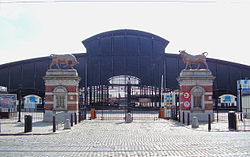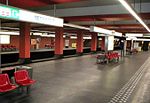Jacques Brel metro station
1982 establishments in BelgiumAnderlechtBelgian railway station stubsBrussels Metro stubsBrussels metro stations ... and 2 more
Jacques BrelRailway stations opened in 1982

Jacques Brel is a Brussels metro station on the western branch of line 5. It is located in the municipality of Anderlecht, in the western part of Brussels (Belgium). It is named after Belgian singer, songwriter, and poet Jacques Brel. The station opened on 6 October 1982 as part of the Beekkant–Saint Guidon/Sint-Guido extension of former line 1B. Following the reorganisation of the Brussels metro on 4 April 2009, it is served by line 5. After the City of Brussels commissioned art projects to enhance the metro network, Maurice Wyckaert was appointed to decorate the station.
Excerpt from the Wikipedia article Jacques Brel metro station (License: CC BY-SA 3.0, Authors, Images).Jacques Brel metro station
Boulevard Jules Graindor - Jules Graindorlaan,
Geographical coordinates (GPS) Address Nearby Places Show on map
Geographical coordinates (GPS)
| Latitude | Longitude |
|---|---|
| N 50.845 ° | E 4.3186111111111 ° |
Address
Jacques Brel
Boulevard Jules Graindor - Jules Graindorlaan
1070
Belgium
Open on Google Maps











